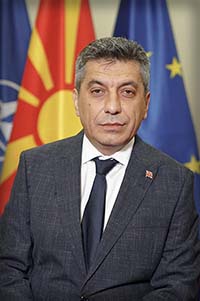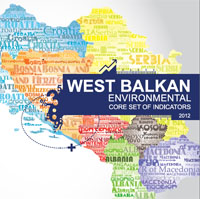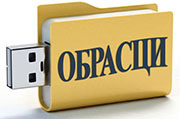| DRINKING WATER QUALITY |
This indicator shows the exceedance of limit values set in Drinking Water Directive (80/778/ЕЕС) and its amendment (98/83/ЕС which entered into force in 2003) and in the Rulebook on drinking water safety (Official Gazette of the Republic of Macedonia No.57/04), as well as the guideline values set for the quality of drinking water by the World Health Organization (WHO, 2004 and 2006).
Exceedance of drinking water quality limit values occurs when the concentration/dose of the pollutant exceeds the limit values specified in the above listed regulations.
Where more than one limit values exist (see the section on Policy goals), the indicator shall adopt the most strict case.
- Number of aerobic mesophilic bacteria in 1 ml,
- Number of coliform bacteria in 100 ml,
- Number of thermo-tolerant coliform bacteria in 100 ml,
- Concentration of physico-chemical pollutants in mg/l,
- Parameters for radiological safety of drinking water in bekerels/l and total indicative dose in mSV/l.
What progress has been made in reducing the concentrations of pollutants in urban and rural environments in order to reach drinking water limit values specified in the Rulebook?
Access to safe drinking water in the Republic of Macedonia amounts 95% (period from 2001 to 2017) with a note that population in urban areas has 99% access to safe drinking water and 78% of rural population has access to health safe drinking water, while the rest is exposed at occasional risk of bacteriological pollution of drinking water.
Figure 1.Drinking water quality in percentage
Data coverage: excel
Source: Public Health Institute of the Republic of Macedonia, PHI – 10 Regional
Sanitary and hygienic condition of facilities and health safety of analyzed water samples are, generally, satisfactory, i.e. within the expected limits compared to previous years. In the period 2001-2017, the percentage of unsafe samples based on physical and chemical analysis ranged between 2.9 and 7.5 %, while the percentage of unsafe samples based on microbiological analysis ranged between 0.8 and 2.99%. The most frequent causes of unsafe findings in the physical and chemical include absence of residual chlorine or increased content of iron in raw water and in very few samples it is due to increased content of nitrites from dag or drilled wells of individual users.
With bacteriologically positive findings, the cause is mostly increased number of aerobic mesophile bacteria. Toxic parameters are within the prescribed legal norms.
In the segment of health safe drinking water supply in rural populated places, the deficiencies in terms of undefined sanitary protection zones around drinking water sources, lack of adequate equipment for drinking water filtering and disinfection and inappropriate technical maintenance, have been constantly present. Therefore, there is high percentage of bacteriologically unsafe (9-25%).
- Methodology for the indicator calculation
The 10 regional Public Health Institutes – Skopje, Kumanovo, Veles, Shtip, Kochani, Strumica, Prilep, Bitola, Ohrid and Tetovo with their hygiene-epidemiological stations, in cooperation with the Public Health Institute – Skopje, carry out regular and continuous monitoring of drinking water corresponding with the number of measuring points and schedule specified in the Rulebook on drinking water safety (Official Gazette of the Republic of Macedonia No.57/04). Institutes perform basic physic-chemical and bacteriological analyses of drinking water samples, while the Public Health Institute of the Republic of Macedonia performs monitoring of periodical physic-chemical analysis, analysis of pesticide residues, analyses of contaminants, parasitological and radiological analysis.
Uncertainty
- Methodological uncertainty
Data is, generally, representative for the whole urban area in the Republic of Macedonia. The indicator is subject to modifications from year to year, depending on the introduction of new drinking water treatment plants and in line with the enhanced trend of rural population coverage with safe drinking water supply.
- Data uncertainty
Data is, generally, representative for the whole urban area in the Republic of Macedonia. Representativeness of monitoring selection is in accordance with the requirements of Directive 98/83/EC.
List of relevant policy documents:
The National Environmental Action Plan – 2 (2006) sets the improvement of the quality of drinking water through reduction of emissions of the main pollutants into surface and groundwaters as its main objective. The same document specifies the primary measure to be applied: to strengthen the processes of drinking water quality monitoring and assessment.
The 1999 National Environmental Health Action Plan (NEHAP) sets two main objectives:
- Reduction and minimization of health risks for the population through provision of drinking water for every citizen, which is safe from health point of view, sufficient in quantity, with guaranteed microbiological, organoleptical and physico-chemical composition, compliant with national standards and WHO Guidelines, as well as waters intended for sports and recreation and healthy food production;
- Reduction of exposure to toxic chemicals through water originating from agriculture and industry.
The NEHAP also sets the following priorities:
- approximation of the legislation on the quality of ambient and drinking waters with the recommendations of the EU (approximation completed in 2004) and with the WHO Guidelines;
- introduction of disincentive prices for non-earmarked consumption of drinking water by commercial and non-commercial users and restrictive prices for the population in circumstances of draught for the purpose of consumption streamlining (implemented under the Law on Drinking Water Supply and Urban Wastewater Collection);
- establishment of sanitary protection zones around water supply sources in order to prevent contamination of anthropogenic origin (permanent process performed and most of the public utilities have established zones in line with the Elaborates for sanitary protection zones developed by the Public Health Institution RIHP and other authorised vocational institutions);
- completion of the process of construction of municipal and industrial wastewater treatment systems;
- monitoring of the quality of surface and groundwaters, especially at drinking water abstraction, places intended for sports and recreation and points for abstraction of water for irrigation, monitoring of discharged untreated and treated municipal and industrial wastewaters in accordance with EU and WHO Guidelines (monitoring is performed regularly and continuously by the Public Health Institute – Skopje and the 10 Regional public health centers with their local units);
- although the pilot project for fluoridation of milk consumed by pre-school children has been initiated, introduction of drinking water fluoridation as the most efficient, the least costly and socially and medically most fair means for massive caries prophylaxis has remained as public health option.
Legal grounds
Law on Health Protection, Law on Waters, Programme for preventive health protection in the Republic of Macedonia, Law on Drinking Water Supply and Urban Wastewater Collection, Decree on Water Classification, which in its Article 2, specifies five classes of surface watercourses, lakes and accumulations and ground water resources.
The Law on Food and Foodstuffs and Materials in Contact with Food, in its Article 4 includes drinking water as food.
Rulebook on drinking water safety(sets frequency of drinking water safety control).
In the Law on Nature Protection, one of the main goals defined in Article 4, item 6 of the Law is the securing of the right of citizens to a healthy environment.
The following EU Directives have been transposed in the new legal acts:
Drinking Water Directive (80/778/ЕЕС) and its amendment (98/83/ЕС which entered into force in 2003).
The Rulebook on drinking water safetyspecifies the limit values for the parameters monitored in drinking water in terms of human health protection.
Limit values of concentrations of certain parameters in drinking water
- According to the said Rulebook, limit values have been specified for the purpose of human health protection, harmonized with the EU Directive and WHO Guidelines on the quality of drinking water (2004).
European Environmental Agency
- Exchange of data on drinking water quality, based on the Council Decision on the establishment of reciprocal exchange of information and data on drinking water quality (98/83/EC).
World Health Organization – ENHIS
- Drinking water quality, in line with the WHO Guidelines on drinking water quality of 1987 and 2004, respectively.
| Code | Title of the indicator | Compliance with CSI/ЕЕАor other indicators | Classification by DPSIR | Type | Linkage with area | Frequency of publication | |
| MKNI 039 | Drinking water quality | WEU13 | Drinking water quality | S | А | Water quality | Annually |






































































